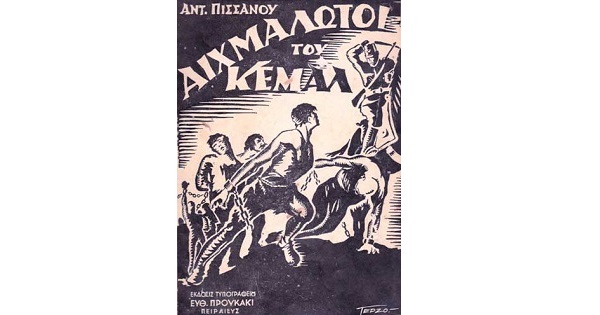
PRISONERS OF KEMAL
[ΑΙΧΜΑΛΩΤΟΙ ΤΟΥ ΚΕΜΑΛ]
Antonios Pissanos
Prodos 1978 (and other publishers)
307 pages
Antonios Pissanos was born in Smyrna. In September 1922 during the Smyrna Holocaust, he was captured iby Kemalist forces and held as a prisoner of war. He was placed in a group of 3,000 men and sent to the interior of Turkey. Along the way many of the prisoners were slaughtered while most of those who survived later died of disease and malnutrition. In the chapter titled A Real Slaughter of Humans, Pissanos recounts when Turkish guards stopped the group somewhere in the interior and began a slaughter of prisoners. He wrote:
Meanwhile the other Turks have gone rabid. They start grabbing prisoners and slaughtering them. A soldier orders a prisoner to start running. The unfortunate man stands hesitantly. The soldier then hits him hard with a whip. The prisoner begins to run like a crazed man. They lift their rifles and shoot him. Within a few meters he falls to the ground, dead.
After that celebration, the Turks ordered us to stand. "Don't be afraid" they told us, "we won't touch anybody else." We got up. Beside me was Kontaksi. The Turkish Cretan who was doing all the slaughtering approached us. I didn't dare lift my head to look at him. I heard him saying: "Come here you." I thought he was talking to me. I felt that my final hour had arrived. But he was talking to the unfortunate Kontaksi, the telegraph worker. He grabbed him by the hand and said to him: "Come here giaour (unbeliever), let me tell you something." He then takes him two meters away from the line. "You look Armenian, I can tell by your face" he says to him. Kontaksi is shocked and takes exception as he realizes that there's a chance Greeks might be spared but not Armenians. But the Turk doesn't listen. He jumps on top of Kontaksi like a rabid animal and grounds him. Then immediately like a bolt of lightning he pulls out a knife, a knife that had been sunk into the flesh of many Christians that day and begins to stab his victim mercilessly as his victim screams and begs in vain. The wicked man doesn't stop until he notices that the injuries were so severe that death was inevitable. He turned to us and said: "That jerk was Armenian." But who would dare tell him he was wrong at that moment? I will never forget those final moments, and the torture that the unlucky Kontaksi had to endure.
In the chapter titled Merciless Carnage at the Gorge of Magnesia, Pissanos recounts his experience when he witnessed the site where the Turks were massacring their captives:
Most of the prisoners who were fortunate enough to return, would have passed through the famous Gorge of Magnesia which is located precisely at Sipylus. It was into that gorge where the prisoners were led and massacred. The corpses were formed into piles there and the sky turned black from the many crows that had gathered at this site of death. It was at this gorge that the League of Nations (the UN today) should have sent its representatives to verify with their own eyes what the Turks were doing in Asia Minor. I am of the opinion that the Turks, even up until today, could not have discarded so many corpses.
Our march continues under the threats, shouting and beatings of the Turks. We run without knowing where we are going, without looking back. All we try to do is outrun one another, running like crazy.
The road we travel on has the shape of a curve. Two hills form a ravine. A terrible stench hits our nostrils. What is there? We want to stop. But how can anyone stop here when the Turks are chasing them on their horses! We approach the curve. I'm virtually in the front row. But as soon as I turn around, I stop in disbelief. At the same time everyone else stops. The scene that appears before us, is absolutely impossible to describe. Imagine a road, not quite paved, but literally full of corpses. The corpses are piled up, like mountains! All the corpses are bloated and half-eaten away. Many of them are soldiers, I know this from their uniforms. The crows are eating their flesh. They fly over our heads, making horrifying noises.
How could we advance from here, since the road is littered with corpses? The Turks, however, are completely indifferent. Yuru giaourlar [walk you infidels], they shout and direct their horses towards us. We start to run toward the hazard, running over the corpses. We run in fear, horrified. The corpses flatten under our weight. We hear their bones breaking and we feel our feet sinking into the dead flesh of our brothers.
Meanwhile, the Turks start shooting at us, butchering us with their knives and trampling on us with their horses. God help the last ones who flee from this humanly mass. Whoever falls will never get up again. The others who are running will trample on them and finish them off. The shooting increases and the bodies fall continuously. The Turco-Cretans only slaughter with knives. A pandemonium is happening. The cries of those being killed, the stampeding of the horses, the grunting of the assassins, is something indescribably horrific.
Translated with the assistance of Lorenzo Riviezzo
Further reading:
The Treatment of the Greek Prisoners in Turkey
The Number 31328: The Book of Slavery
17 Jul 1923: Thousands of Greeks Disappear, Advocate
Did the Kemalists sell the bodies of Greeks and Armenians for industrial use?
Prisoner of the Turks



